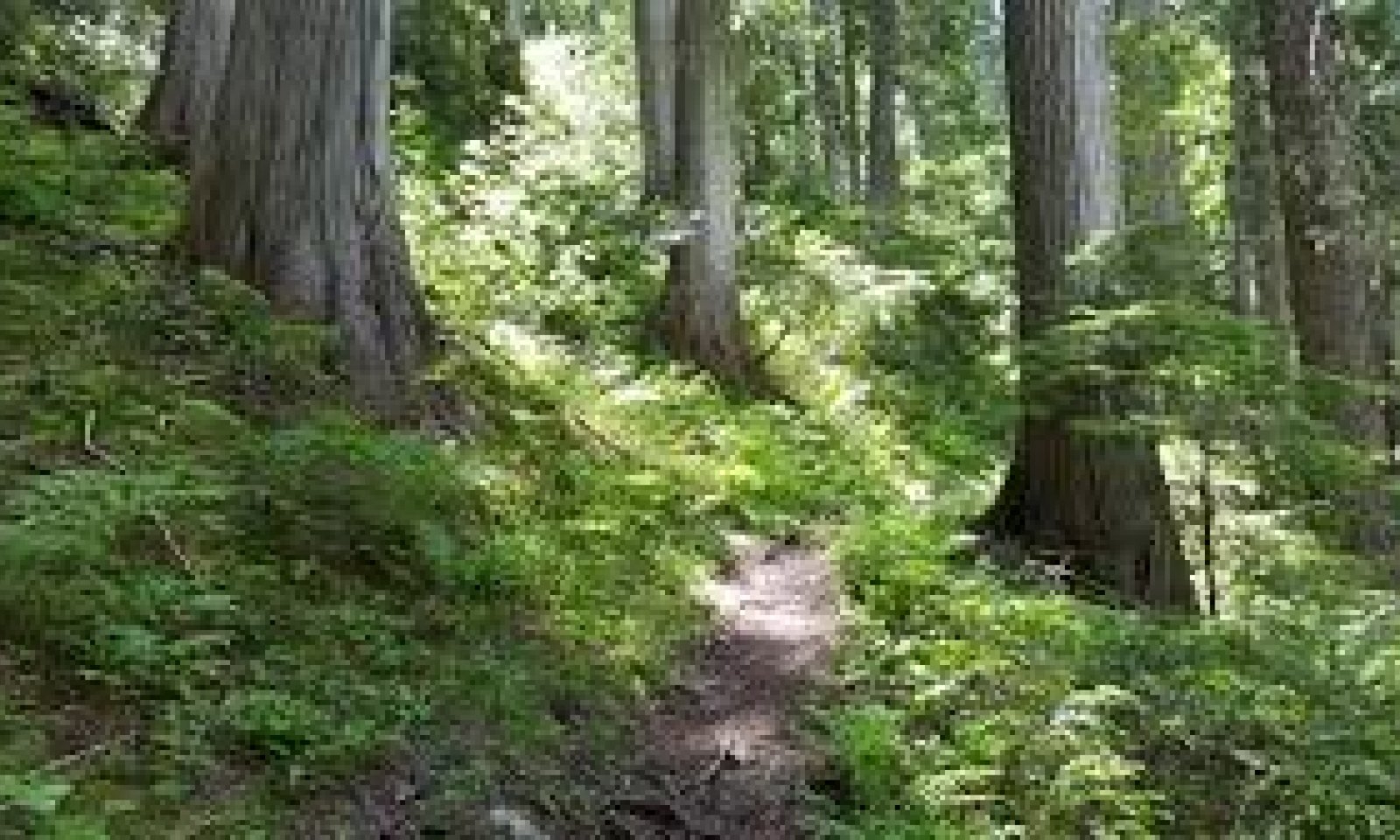

Natural Resources
Conservation Service
Ecological site F043AY557ID
Ashy Till Mountains and Valleys 30-45" PZ Frigid Bitterroot Metasedimentary Zone
Last updated: 4/10/2025
Accessed: 12/19/2025
General information
Provisional. A provisional ecological site description has undergone quality control and quality assurance review. It contains a working state and transition model and enough information to identify the ecological site.
MLRA notes
Major Land Resource Area (MLRA): 043A–Northern Rocky Mountains
Major Land Resource Area (MLRA): 043A–Northern Rocky Mountains
Description of MLRAs can be found in: United States Department of Agriculture, Natural Resources Conservation Service. 2006. Land Resource Regions and Major Land Resource Areas of the United States, the Caribbean, and the Pacific Basin. U.S. Department of Agriculture Handbook 296.
Available electronically at: http://www.nrcs.usda.gov/wps/portal/nrcs/detail/soils/ref/?cid=nrcs142p2_053624#handbook
LRU notes
Most commonly found in LRU 43A11 (Bitterroot Metasedimentary Zone). Climate parameters were obtained from PRISM and other models for the area. Landscape descriptors are derived from USGS DEM products and their derivatives.
Classification relationships
Relationship to Other Established Classifications:
United States National Vegetation Classification (2008), A3612 Western Hemlock – Western Redcedar Cool-Mesic Central Rocky Mountain Forest & Woodland Alliance.
Washington Natural Heritage Program. Ecosystems of Washington State, A Guide to Identification, Rocchio and Crawford, 2015 - Northern Rocky Mt. Mesic Montane Mixed Conifer Forest (Cedar-Hemlock)
Description of Ecoregions of the United States, USFS PN # 1391, 1995 - M333 Northern Rocky Mt. Forest-Steppe-Coniferous Forest-Alpine Meadow Province
Level III and IV Ecoregions of WA, US EPA, June 2010 – 15y Selkirk Mountains, 15w Western Selkirk Maritime Forest.
This ecological site includes the following USDA Forest Service Plant Associations Western Hemlock Series: TSHE/CLUN, TSHE/ASCA. (Williams et. al. 1995)
Ecological site concept
This ecological site is the most productive in terms of forest production and biodiversity. It can be highly dynamic in forest succession depending on seed source, degree of disturbance, and shrub completion. Western larch has taken over the role of early successor since the western white pine blister rust epidemic. A whole range of tree species can be found through forest succession. Eventually, without major disturbance stands of Douglas-fir, larch, grand fir and white pine are overtaken by western hemlock and western redcedar. These cedar-hemlock stands will perpetuate until a major stand replacing fire occurs. The soils have developed in moderately thick (7-14 inch) Mazama tephra deposits over alluvium or local till from mixed sources. The soils are very deep and have low available water capacity to a depth of 40 inches. The soils are well drained and do not have a water table within 30 inches of the surface at any time throughout the year.
Table 1. Dominant plant species
| Tree |
(1) Tsuga heterophylla |
|---|---|
| Shrub |
(1) Lonicera utahensis |
| Herbaceous |
(1) Clintonia uniflora |
Physiographic features
Physiographic Features
Landscapes: Mountains, Valleys
Landform: mountain slopes, valley sides
Elevation (m): Total range = 550 to 1775 m
(1,805 to 5,820 feet)
Central tendency = 975 to 1345m
(3,200 to 4,410 feet)
Slope (percent): Total range = 0 to 105 percent
Central tendency = 25 to 60 percent
Aspect: Total range: 240-15-160
Central tendency: 300-15-60
Table 2. Representative physiographic features
| Landforms |
(1)
Mountains
> Mountain slope
(2) Valley > Valley side |
|---|---|
| Flooding frequency | None |
| Ponding frequency | None |
| Elevation | 3,200 – 4,410 ft |
| Slope | 25 – 60% |
| Water table depth | 80 in |
| Aspect | NW, N, NE, E |
Table 3. Representative physiographic features (actual ranges)
| Flooding frequency | None |
|---|---|
| Ponding frequency | None |
| Elevation | 1,805 – 5,820 ft |
| Slope | 100% |
| Water table depth | 80 in |
Climatic features
Climatic Features
Frost-free period (days): Total range = 80 to 125 days
Central tendency = 95 to 105 days
Mean annual precipitation (cm): Total range = 600 to 2315 mm
(24 to 64 inches)
Central tendency = 765 to 1385 mm
(30 to 55 inches)
MAAT (C): Total range = 2.9 to 8.1
(37 to 47 F)
Central tendency = 5.0 to 6.3
(41 to 43 F)
Climate Stations: none
Influencing water features
Water Table Depth: >80 inches
Flooding:
Frequency: None
Duration: None
Ponding:
Frequency: None
Duration: None
Soil features
Representative Soil Features
This ecological subsite is associated with the Pearsoncreek family soil component. These soils are Andic Dystrudepts. They have developed in moderately thick (7-14 inches) Mazama tephra deposits over alluvium or local till from mixed sources. The soils are very deep and have low available water capacity to a depth of 40 inches. The soils are well drained.
Table 4. Representative soil features
| Parent material |
(1)
Volcanic ash
(2) Alluvium (3) Till |
|---|---|
| Surface texture |
(1) Gravelly, ashy silt loam |
| Drainage class | Well drained |
| Permeability class | Moderate |
| Depth to restrictive layer | 80 in |
| Surface fragment cover >3" | Not specified |
| Available water capacity (0-40in) |
2.2 in |
| Calcium carbonate equivalent (0-60in) |
Not specified |
| Electrical conductivity (0-60in) |
Not specified |
| Soil reaction (1:1 water) (0-60in) |
5.8 |
| Subsurface fragment volume <=3" (10-60in) |
55% |
| Subsurface fragment volume >3" (10-60in) |
20% |
Table 5. Representative soil features (actual values)
| Drainage class | Well drained |
|---|---|
| Permeability class | Moderate |
| Depth to restrictive layer | 80 in |
| Surface fragment cover >3" | Not specified |
| Available water capacity (0-40in) |
2.2 in |
| Calcium carbonate equivalent (0-60in) |
Not specified |
| Electrical conductivity (0-60in) |
Not specified |
| Soil reaction (1:1 water) (0-60in) |
5.1 – 6.5 |
| Subsurface fragment volume <=3" (10-60in) |
15 – 65% |
| Subsurface fragment volume >3" (10-60in) |
65% |
Ecological dynamics
Ecological Dynamics of the Site
This site occurs most commonly on north slopes, cool benches, and dissected drainages in Northern Idaho and NE Washington. The depth of volcanic ash in the soil along with high precipitation makes this site highly productive. It is recognized by USFS Forest Habitat Types of Northern Idaho as the Western hemlock / Queenscup beadlily and Western hemlock / Wild Ginger habitat types. The WH/beadlilly habitat type is the most prolific and occurs on all aspects. The wild ginger type occurs on moister landscapes, usually on toe slopes or drainage areas. The cooler portions of this site occur at higher elevation lack western redcedar and have rusty menziesia as key shrub indicator.
This site has the highest ecological dynamics depending on type and degree of disturbance, and tree species seed source. Western hemlock and western redcedar will eventually dominate the overstory without major fire disturbance. Grand fir, Douglas-fir, western white pine, and western larch could be present in varying amounts. Understory reproduction and 2nd level overstory will be dominated by western hemlock and western redcedar due to their high degree of shade tolerance. There will be a large component of downed wood caused by windthrow, seral species die-out, and insect and disease mortality. Paper birch is a key deciduous tree species in this hemlock-cedar ecological site. It can be a prominent understory component in early to mature stands and eventually dies out in the late climax forest.
Fire frequency in these stands occurs in long intervals of 150+ years. Due to the large volume of wood, stand replacing fires were the norm leaving the site naturally reforested by western white pine. After the white pine blister rust epidemic western larch, Douglas-fir, and in drier areas ponderosa pine gets established depending on seed source and competing shrub species. Grand fir, western hemlock, and western redcedar will also reestablish on the site through time. Lodgepole pine can be present and prevalent on sites after fire.
Ceanothus, alder species, and Douglas maple can reestablish quickly on these burnt sites slowing down natural reforestation. Reoccurring severe fires causing soil degradation can keep the site in a shrub dominated condition for long periods. Western larch is not as hardy as western white pine in competing with the brush species through natural regeneration. Larch needs to immediately establish on bare soil without much competition. The loss of the dominant white pine component again has caused a higher occurrence of Douglas-fir, grand fir, western hemlock, and western redcedar in developing stands.
The understory vegetation can be very rich in areas receiving enough sunlight. Key species include Queenscup beadlily, hooker fairybells, starry Solomon seal, wintergreen, huckleberry spp., and sword fern.
State and transition model
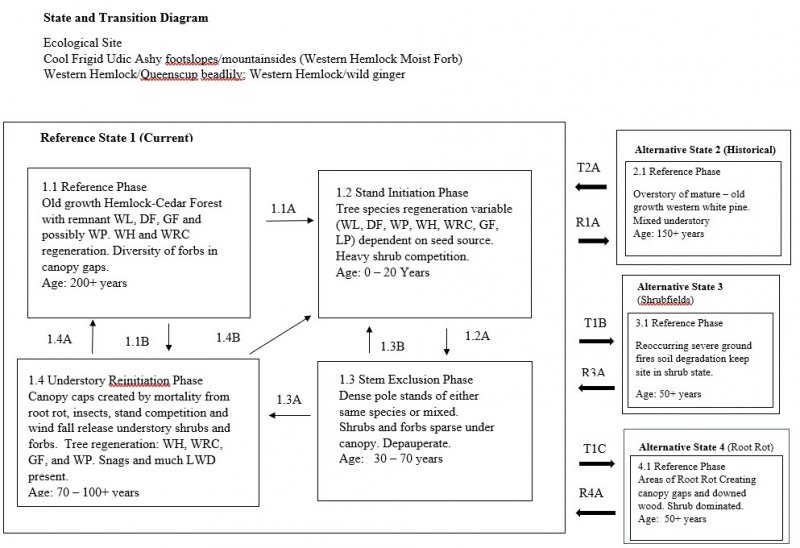
More interactive model formats are also available.
View Interactive Models
More interactive model formats are also available.
View Interactive Models
Click on state and transition labels to scroll to the respective text
Ecosystem states
State 1 submodel, plant communities
State 2 submodel, plant communities
State 3 submodel, plant communities
State 4 submodel, plant communities
State 1
Reference
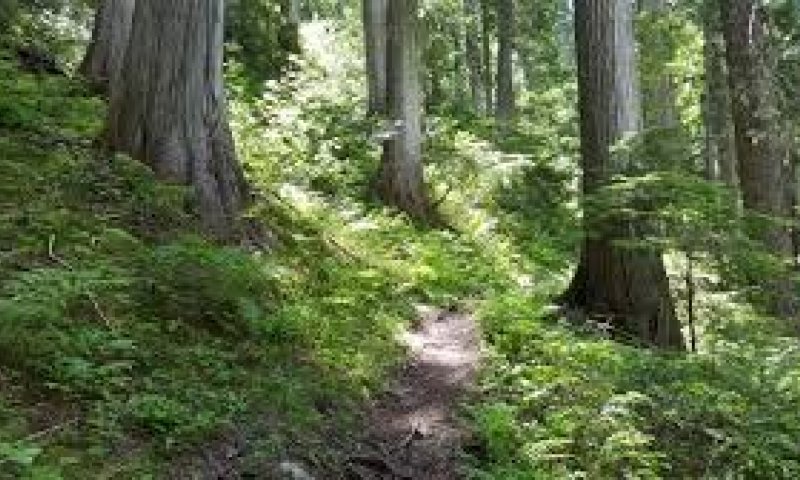
This state results in an old growth western hemlock and western redcedar forest. Fire return intervals are far apart due to its moist environment. It is highly dynamic in its seral stages after major disturbance with many tree species capable of establishing and growing to mature age. Western white pine used to be a dominant tree in this state establishing after a severe fire and be a major overstory component in the mature to old growth phase, however, the white pine blister rust epidemic in the 1930s reduced it to a minor component in stand composition of current forests. White pine stabilized the site for long periods due to its disease and insect resistance. Currently Western Larch, Douglas-fir, Grand fir, cedar, and hemlock have taken its place in early stand establishment through the mature and old growth phases. This has led to more root rot in mature stands with Douglas-fir, Grand fir, cedar, and hemlock. Eventually, western hemlock and western redcedar dominate regeneration in mature stands and a hemlock-cedar forest develops without major disturbance. This state can be floristically rich with shrubs and herbs when canopy gaps are created. Major shrub species include big huckleberry, twinflower, pachistima, prince’s pine, pyrola, honeysuckle, and rose. Herbs include queencup beadlily, violet, western rattlesnake plantain, wild ginger, sword fern, Hooker fairybells, and twisted stalk. A key understory tree species in this ecological site is paper birch. It is usually more prominent early to middle seral stages and notable snags present in mature to old growth phases. Another key seral species descriptive of this ecological site is Sitka alder. It is present during the stand initiation phase located in moisture receiving areas. Redstem and snowbrush ceanothus species can be prominent in fire disturbed areas. Black cottonwood is also prominent seral species and usually died out by the mature forest phase.
Community 1.1
Reference

Old growth stands of western hemlock and western redcedar 200+ years old. Grand fir, Douglas-fir, and western larch may be present in the overstory. Second level overstory mostly western hemlock, western redcedar. . Natural regeneration mostly western hemlock and some western redcedar, some grand fir, Douglas-fir, and white pine possible. Canopy openings from windthrow or root rot advance understory forb/shrub vegetation, and hemlock and cedar regeneration. Large volume of down and dead wood. Without major disturbance this community phase will perpetuate itself with hemlock and cedar.
Dominant plant species
-
western hemlock (Tsuga heterophylla), tree
-
western redcedar (Thuja plicata), tree
-
grand fir (Abies grandis), tree
-
Rocky Mountain Douglas-fir (Pseudotsuga menziesii var. glauca), tree
-
western larch (Larix occidentalis), tree
-
western white pine (Pinus monticola), tree
-
thinleaf huckleberry (Vaccinium membranaceum), shrub
-
longtube twinflower (Linnaea borealis ssp. longiflora), shrub
-
Oregon boxleaf (Paxistima myrsinites), shrub
-
pipsissewa (Chimaphila umbellata), shrub
-
wintergreen (Pyrola), shrub
-
Utah honeysuckle (Lonicera utahensis), shrub
-
dwarf rose (Rosa gymnocarpa), shrub
-
bride's bonnet (Clintonia uniflora), other herbaceous
-
darkwoods violet (Viola orbiculata), other herbaceous
-
western rattlesnake plantain (Goodyera oblongifolia), other herbaceous
-
western swordfern (Polystichum munitum), other herbaceous
-
Canadian wildginger (Asarum canadense), other herbaceous
-
Oregon drops of gold (Prosartes hookeri var. oregana), other herbaceous
-
claspleaf twistedstalk (Streptopus amplexifolius), other herbaceous
Community 1.2
Stand Initiation
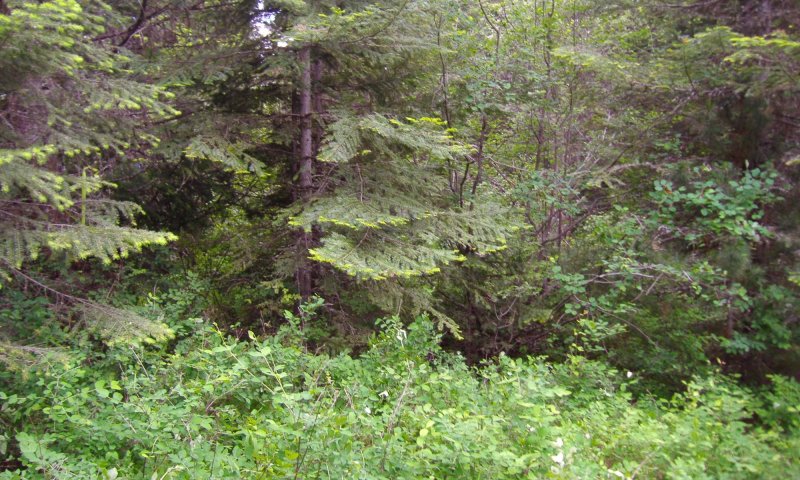
Stand replacing fire creates seedbed for natural regeneration. Natural regeneration species composition depends on available seed source and level of disturbance. Western white pine can no longer dominate natural regeneration due to blister rust. Western larch has taken over to a lesser degree and can dominate natural regeneration after hot burns exposing mineral soil and good seed dispersal years. Otherwise mixed species natural regeneration will occur with the whole tree species mix of this ecological site occurring. Severe disturbance can advance shrub competition from ceanothus species, alder, willow, snowberry, and ribes spp. which deter natural regeneration. Paper birch and black cottonwood can also be present in this early stage.
Dominant plant species
-
western larch (Larix occidentalis), tree
-
Rocky Mountain Douglas-fir (Pseudotsuga menziesii var. glauca), tree
-
grand fir (Abies grandis), tree
-
ponderosa pine (Pinus ponderosa), tree
-
western white pine (Pinus monticola), tree
-
paper birch (Betula papyrifera), tree
-
black cottonwood (Populus balsamifera ssp. trichocarpa), tree
-
ceanothus (Ceanothus), shrub
-
Sitka alder (Alnus viridis ssp. sinuata), shrub
-
Scouler's willow (Salix scouleriana), shrub
-
common snowberry (Symphoricarpos albus), shrub
-
currant (Ribes), shrub
Community 1.3
Stem Exclusion
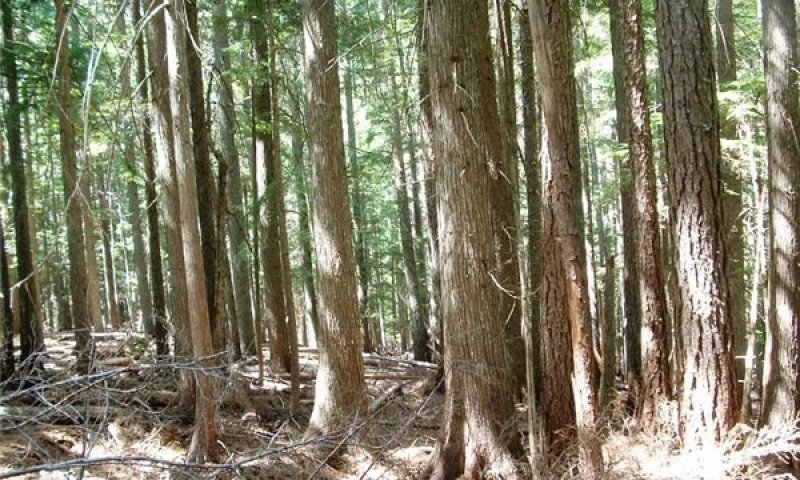
Dense pole to early mature stands 20 to 100 years old. Stand composition depending on natural regeneration. Stands could be consist of mainly western hemlock and western redcedar, solid stands of western larch, or a mix of western larch, western white pine, Douglas-fir, and grand fir. Western hemlock and western redcedar may be present in understory of these mixed stands. Due to high moisture and ash depth in soils sites can carry high stand densities. Understory vegetation is depauperate.
Dominant plant species
-
grand fir (Abies grandis), tree
-
Rocky Mountain Douglas-fir (Pseudotsuga menziesii var. glauca), tree
-
western larch (Larix occidentalis), tree
-
western white pine (Pinus monticola), tree
-
western redcedar (Thuja plicata), tree
-
western hemlock (Tsuga heterophylla), tree
-
pipsissewa (Chimaphila umbellata), shrub
-
bride's bonnet (Clintonia uniflora), other herbaceous
-
Canadian wildginger (Asarum canadense), other herbaceous
Community 1.4
Understory Reinitiation
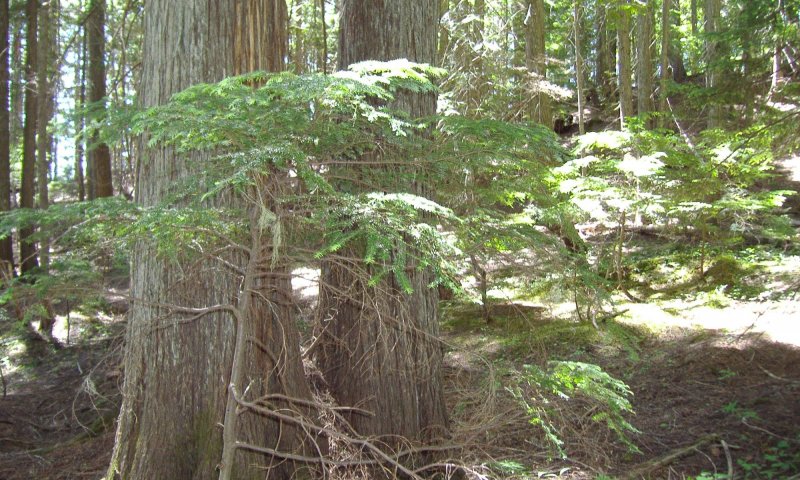
Canopy gaps for overstory mortality allow understory shrubs and herbs to increase. Stand competition, Armillaria root rot, bark beetles, and defoliators causes mortality in hemlock, grand fir and Douglas-fir. Western redcedar and western hemlock dominate regeneration. Overstory dominated by cedar and hemlock, however, western larch, Douglas-fir, and grand fir can compose of good percentage of the overstory depending on initial stand establishment. Snags and downed wood scattered throughout stand.
Dominant plant species
-
western redcedar (Thuja plicata), tree
-
western hemlock (Tsuga heterophylla), tree
-
grand fir (Abies grandis), tree
-
western larch (Larix occidentalis), tree
-
Oregon boxleaf (Paxistima myrsinites), shrub
-
pipsissewa (Chimaphila umbellata), shrub
-
longtube twinflower (Linnaea borealis ssp. longiflora), shrub
-
bride's bonnet (Clintonia uniflora), other herbaceous
-
Canadian wildginger (Asarum canadense), other herbaceous
-
Oregon drops of gold (Prosartes hookeri var. oregana), other herbaceous
Pathway 1.1A
Community 1.1 to 1.2


Stand Replacing Fire
Pathway 1.1B
Community 1.1 to 1.4


Canopy caps open form due to overstory mortality – root rot, insects, windthrow, and mixed severity fires (infrequent)
Pathway 1.2A
Community 1.2 to 1.3


– Time. Tree regeneration grows into dense pole stands
Pathway 1.3B
Community 1.3 to 1.2


Stand replacing fire
Pathway 1.3A
Community 1.3 to 1.4


Time. Crown competition from dense pole to early mature stands, root rot, insect mortality, and wind fall create canopy gaps
Pathway 1.4A
Community 1.4 to 1.1


Time. Stand matures and stabilizes until severe disturbance.
Pathway 1.4B
Community 1.4 to 1.2


Stand replacing fire
State 2
Historic Reference
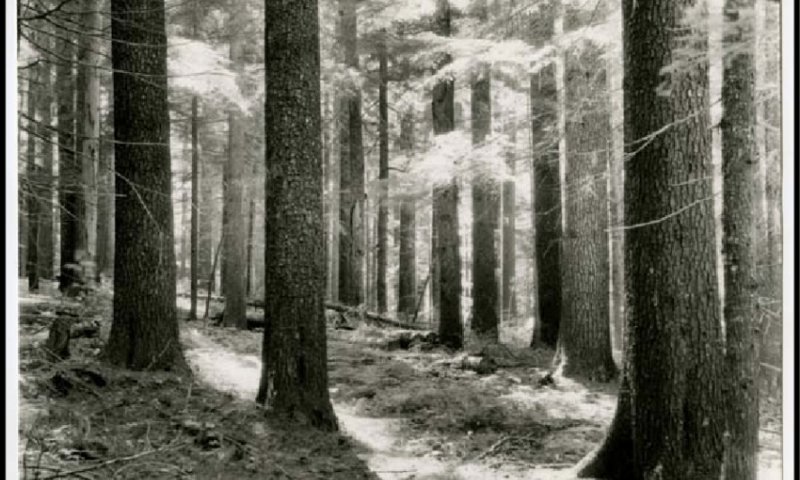
Before the 1910 outbreak of western white pine blister rust N. Idaho and parts of NE WA were covered with white pine stands from pole to old growth stages. Severe fires over large acreages allowed white pine to establish and dominate the area. Mature to old growth stands of pine stabilized the area due to its root rot and insect resistance. A mixed understory of shrubs and forbs existed due to sufficient light coming through the white pine canopy. Cedar and hemlock regeneration would also have been present. Large fires again would allow the white pine to establish and the cycle would start again. The blister rust epidemic basically wiped out the white pine and eliminated this stable forest cycle. In its place Douglas-fir, grand fir, western larch, cedar, and hemlock increased in abundance through the growth stages. More root rot and insect mortality are now present in the stands. In addition, more cedar-hemlock stands reach old stages without a white pine component. To address the white pine blister rust problem cooperative forestry organizations developed a blister rust resistant white pine that has been planted on hemlock and cedar sites. White pine can now be seen growing on these harvested areas.
Community 2.1
Reference
Mature to old growth stands of western white pine over a mixed understory of shrubs and forbs. Cedar and hemlock regeneration could be present. Douglas-fir, western larch, and grand fir could be present in the main white pine overstory.
Dominant plant species
-
western white pine (Pinus monticola), tree
-
western hemlock (Tsuga heterophylla), tree
-
western redcedar (Thuja plicata), tree
-
grand fir (Abies grandis), tree
-
Rocky Mountain Douglas-fir (Pseudotsuga menziesii var. glauca), tree
-
pipsissewa (Chimaphila umbellata), shrub
-
longtube twinflower (Linnaea borealis ssp. longiflora), shrub
-
Utah honeysuckle (Lonicera utahensis), shrub
-
bride's bonnet (Clintonia uniflora), other herbaceous
-
Canadian wildginger (Asarum canadense), other herbaceous
State 3
Shrubfields
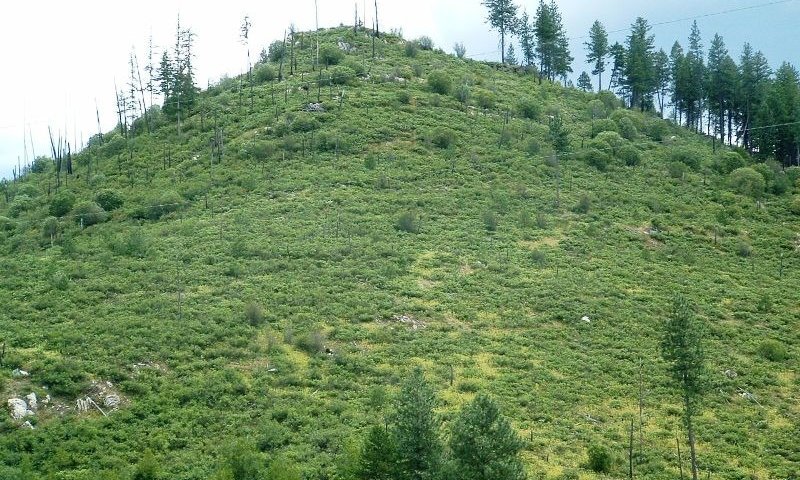
Multiple severe fires keep site in a shrub field state.
Community 3.1
Reference
Major shrubs like ceanothus spp., Douglas maple, alder, snowberry, serviceberry, scouler willow, buffalo berry, and huckleberry will dominate site for long periods. Tree regeneration very slow depending on fire and soil degradation
Dominant plant species
-
ceanothus (Ceanothus), shrub
-
Rocky Mountain maple (Acer glabrum), shrub
-
Sitka alder (Alnus viridis ssp. sinuata), shrub
-
common snowberry (Symphoricarpos albus), shrub
-
Saskatoon serviceberry (Amelanchier alnifolia), shrub
-
Scouler's willow (Salix scouleriana), shrub
-
russet buffaloberry (Shepherdia canadensis), shrub
-
thinleaf huckleberry (Vaccinium membranaceum), shrub
State 4
Root Rot
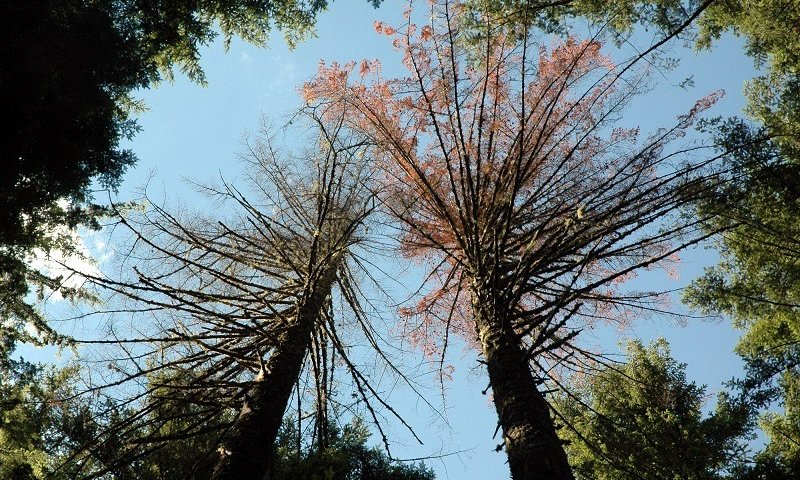
With the increased abundance of Douglas-fir, grand fir, and hemlock in stand development since the white pine bister rust epidemic Armillaria root rot has increased creating pockets to large areas of shrub/small deciduous trees. These root rot areas can exist for long periods until resistant species establish. In areas with metasedimentary parent material this situation is amplified. Species resistant to Armillaria include western larch, white pine, and western redcedar (after seedling stage).
Community 4.1
Reference
Shrub and small deciduous tree dominated areas created from root rot mortality in Douglas-fir, grand fir, and western hemlock. Much downed wood.
Dominant plant species
-
western redcedar (Thuja plicata), tree
-
western larch (Larix occidentalis), tree
-
western white pine (Pinus monticola), tree
Transition R1A
State 1 to 2


To return to the historical state of white pine dominant late seral forests landscape level planting of blister rust resistant white pine after large stand replacing fires or clearcut regeneration harvests
Transition T1B
State 1 to 3


Severe fire causing soil degradation or reoccurring fires in stand initiation phase keep state in a shrub state.
Transition T1C
State 1 to 4


Root rot, mainly Armillaria, killing hemlock, Douglas-fir, and grand fir creates small to large areas dominated by shrubs or small deciduous trees.
Restoration pathway T2A
State 2 to 1


White pine blister rust eliminated white pine as a long term overstory dominant moving to cedar-hemlock forest
Restoration pathway R3A
State 3 to 1


Site by site analysis to determine feasibility of tree planting.
Restoration pathway R4A
State 4 to 1


Where feasible, planting blister rust resistant white pine, western larch, and western redcedar in root rot pockets.
Additional community tables
Interpretations
Wood products
sawtimber, pulp, cedar shakes and posts
Other products
Mushrooms, cedar boughs
Table 6. Representative site productivity
| Common name | Symbol | Site index low | Site index high | CMAI low | CMAI high | Age of CMAI | Site index curve code | Site index curve basis | Citation |
|---|---|---|---|---|---|---|---|---|---|
| western white pine | PIMO3 | 60 | 93 | 118 | 180 | 100 | – | – | |
| grand fir | ABGR | 60 | 98 | 76 | 149 | 100 | – | – | |
| western larch | LAOC | 56 | 85 | 74 | 132 | 70 | – | – | |
| Rocky Mountain Douglas-fir | PSMEG | 72 | 85 | 83 | 116 | 110 | – | – | |
| Rocky Mountain Douglas-fir | PSMEG | 66 | 100 | 71 | 97 | 90 | – | – |
Supporting information
References
-
. Idaho Department of Lands H.T. Groupings based on Forest HTs of Northern Idaho.
-
Cooper, S.V., K.E. Neiman, R. Steele, and D.W. Roberts. 1991. Forest Habitat types of Northern Idaho, A Second Approximation.
-
Finklin, A.I. 1983. Climate of Priest River Experimental Forest, northern Idaho. Gen. Tech. Rep. INT-159. U.S. Department of Agriculture, Forest Service, Intermountain Forest and Range Experiment Station, Ogden, UT. 53.
-
Loehman, R.A., J.A. Clark, and R.E. Keane. 2011. Modeling Effects of Climate Change and Fire Management on Western White Pine (Pinus monticola) in the Northern Rocky Mountains, USA. Forests 2011:832–860.
-
McDonald, G.L., A.E. Harvey, and J.R. Tonn. 2000. Fire, Competition, and Forest Pests: Landscape Treatment to Sustain Ecosystem Functions, The Joint Fire Science Conference and Workshop.. Pages 195–211 in Proceedings from the Joint Fire Science Conference and Workshop: crossing the millennium: integrating spatial technologies and ecological principles for a new age in fire management.
-
Miller and Gravelle. October, 2005. Species Selection Guidelines for Planting, Natural Regeneration and Crop Tree Selection on Potlatch Land in Northern Idaho, Forestry Technical Paper TP -2003-1.
-
Smith and Fischer. 1997. Fire Ecology of the Forest Habitat Types of Northern Idaho.
-
Williams, C.K., B.F. Kelley, B.G. Smith, and T.R. Lillybridge. October, 1995. Forested Plant Associations of the Colville National Forest.
-
Zack, A. 1994. Early Succession in Western Hemlock Habitat Types of Northern Idaho.
-
Zack, A. 1997. Biophysical Classification- Habitat Groups and Description of Northern Idaho and Northwestern Montana, Lower Clarkfork and Adjacent Areas..
Approval
Kirt Walstad, 4/10/2025
Rangeland health reference sheet
Interpreting Indicators of Rangeland Health is a qualitative assessment protocol used to determine ecosystem condition based on benchmark characteristics described in the Reference Sheet. A suite of 17 (or more) indicators are typically considered in an assessment. The ecological site(s) representative of an assessment location must be known prior to applying the protocol and must be verified based on soils and climate. Current plant community cannot be used to identify the ecological site.
| Author(s)/participant(s) | |
|---|---|
| Contact for lead author | |
| Date | 12/18/2020 |
| Approved by | Kirt Walstad |
| Approval date | |
| Composition (Indicators 10 and 12) based on | Annual Production |
Indicators
-
Number and extent of rills:
-
Presence of water flow patterns:
-
Number and height of erosional pedestals or terracettes:
-
Bare ground from Ecological Site Description or other studies (rock, litter, lichen, moss, plant canopy are not bare ground):
-
Number of gullies and erosion associated with gullies:
-
Extent of wind scoured, blowouts and/or depositional areas:
-
Amount of litter movement (describe size and distance expected to travel):
-
Soil surface (top few mm) resistance to erosion (stability values are averages - most sites will show a range of values):
-
Soil surface structure and SOM content (include type of structure and A-horizon color and thickness):
-
Effect of community phase composition (relative proportion of different functional groups) and spatial distribution on infiltration and runoff:
-
Presence and thickness of compaction layer (usually none; describe soil profile features which may be mistaken for compaction on this site):
-
Functional/Structural Groups (list in order of descending dominance by above-ground annual-production or live foliar cover using symbols: >>, >, = to indicate much greater than, greater than, and equal to):
Dominant:
Sub-dominant:
Other:
Additional:
-
Amount of plant mortality and decadence (include which functional groups are expected to show mortality or decadence):
-
Average percent litter cover (%) and depth ( in):
-
Expected annual annual-production (this is TOTAL above-ground annual-production, not just forage annual-production):
-
Potential invasive (including noxious) species (native and non-native). List species which BOTH characterize degraded states and have the potential to become a dominant or co-dominant species on the ecological site if their future establishment and growth is not actively controlled by management interventions. Species that become dominant for only one to several years (e.g., short-term response to drought or wildfire) are not invasive plants. Note that unlike other indicators, we are describing what is NOT expected in the reference state for the ecological site:
-
Perennial plant reproductive capability:
Print Options
Sections
Font
Other
The Ecosystem Dynamics Interpretive Tool is an information system framework developed by the USDA-ARS Jornada Experimental Range, USDA Natural Resources Conservation Service, and New Mexico State University.
Click on box and path labels to scroll to the respective text.